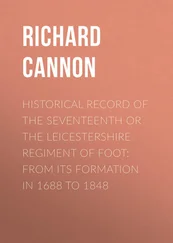Richard Cannon - Historical Record of the Third or Prince of Wales' Regiment of Dragoon Guards - From Its Formation in 1685 to 1838
Здесь есть возможность читать онлайн «Richard Cannon - Historical Record of the Third or Prince of Wales' Regiment of Dragoon Guards - From Its Formation in 1685 to 1838» — ознакомительный отрывок электронной книги совершенно бесплатно, а после прочтения отрывка купить полную версию. В некоторых случаях можно слушать аудио, скачать через торрент в формате fb2 и присутствует краткое содержание. Издательство: Иностранный паблик, Жанр: foreign_antique, foreign_prose, на английском языке. Описание произведения, (предисловие) а так же отзывы посетителей доступны на портале библиотеки ЛибКат.
- Название:Historical Record of the Third or Prince of Wales' Regiment of Dragoon Guards: From Its Formation in 1685 to 1838
- Автор:
- Издательство:Иностранный паблик
- Жанр:
- Год:неизвестен
- ISBN:нет данных
- Рейтинг книги:4 / 5. Голосов: 1
-
Избранное:Добавить в избранное
- Отзывы:
-
Ваша оценка:
- 80
- 1
- 2
- 3
- 4
- 5
Historical Record of the Third or Prince of Wales' Regiment of Dragoon Guards: From Its Formation in 1685 to 1838: краткое содержание, описание и аннотация
Предлагаем к чтению аннотацию, описание, краткое содержание или предисловие (зависит от того, что написал сам автор книги «Historical Record of the Third or Prince of Wales' Regiment of Dragoon Guards: From Its Formation in 1685 to 1838»). Если вы не нашли необходимую информацию о книге — напишите в комментариях, мы постараемся отыскать её.
Historical Record of the Third or Prince of Wales' Regiment of Dragoon Guards: From Its Formation in 1685 to 1838 — читать онлайн ознакомительный отрывок
Ниже представлен текст книги, разбитый по страницам. Система сохранения места последней прочитанной страницы, позволяет с удобством читать онлайн бесплатно книгу «Historical Record of the Third or Prince of Wales' Regiment of Dragoon Guards: From Its Formation in 1685 to 1838», без необходимости каждый раз заново искать на чём Вы остановились. Поставьте закладку, и сможете в любой момент перейти на страницу, на которой закончили чтение.
Интервал:
Закладка:
Two days after this action, in which Viscount Dundee was killed, and the command of the mountaineers devolved on Brigadier-General Cannon, the Fourth Horse joined General Mackay, who proceeded with the reinforcements he received towards St. Johnston , to prevent the junction of the disaffected in the shires of Perth and Angus with the rebels, and to keep the latter to the hills. When on this march, a squadron of the regiment highly distinguished itself in an action with a detachment of the enemy, and fully verified the previous commendatory assertions of General Mackay in behalf of the corps. The particulars of this encounter are as follow.
This casual encounter produced important results. The enemy, disheartened by the repulse, proceeded towards the north, keeping near the Grampian Hills; and General Mackay with 1400 horse and dragoons marched along the plains at the base of the hills, to restrain the enemy from descending. In this service the Fourth Horse were subject to many harassing marches and counter-marches. By day the troops were perpetually in motion; during the night they lay in the fields in a body; and their commander having no confidence in the reports of the country people, who were nearly all hostile to the existing government, he was continually sending out small parties throughout the night to procure intelligence. At length the enemy retreated over the mountains by paths inaccessible to cavalry, and many of the Highlanders proceeded to their homes.
The regiment having sustained considerable loss in this campaign from fatigue and privation, particularly in horses, marched into England to recruit, and was quartered at Warwick and Stratford-upon-Avon.
Having completed its ranks to the numbers borne on the establishment, the regiment marched to the vicinity of the metropolis, and in June, 1690, it furnished a relay of escorts to attend the King to Highlake, in Cheshire, where His Majesty embarked for Ireland, in order to rescue that kingdom from the power of King James. The regiment was subsequently employed in assisting the Life Guards in their attendance on the court; for several months it furnished a daily guard for the Queen-Dowager, at Windsor; and one troop afterwards accompanied Her Majesty to Newmarket.
From the south of England the regiment marched in the spring of 1691 to Lancashire; but it returned to the south in November of the same year, and on the 25th of that month received orders to embark for foreign service.
King William was actively engaged in a war with Louis XIV., who used every means to promote the aggrandizement of France. The Fourth Horse formed part of a reinforcement sent to the British army on the Continent; and, after landing at Williamstadt in North Brabant, they marched to Flanders, and went into village cantonments.
On the 23rd of January, 1692, John Lord Berkeley was appointed Colonel of the regiment, in succession to Lord Colchester, who was promoted to the command of the Third Troop of Life Guards. 14 14 War-Office Records.
The Fourth Horse were called from their cantonments in the spring of 1692, to engage in active operations; and they formed part of the army commanded by King William in person, which advanced to the relief of Namur, when that fortress was besieged by the French. But on arriving at the banks of the Mehaine, that river was found impassable from heavy rains; the enemy arriving on the opposite bank, the two armies viewed each other across the river, but no action took place; and while the army was thus delayed, Namur fell into the hands of the enemy. The Fourth Horse were subsequently engaged in several manœuvres; and they took part in the attack of the French in their position near Steenkirk , on the 3rd of August.
On this occasion they formed part of the leading column which, after passing along several narrow defiles and through some woody grounds, deployed on a small plain in front of the enemy, and commenced the attack in gallant style; but not being sustained by the main army, the corps in advance, after gaining considerable advantage and displaying great valour, were obliged to retire. The Fourth Horse, after driving back some French squadrons, had advanced to the right skirts of a wood on the left wing, and their gallant bearing, under a heavy fire which thinned the ranks, was conspicuous; but they were eventually forced from their ground by the torrent of superior numbers which came pouring down upon their front. The King ordered a retreat, and the troops performed the difficult operation of retiring through a broken country in presence of an army of superior numbers, in fine order.
After several marches and changes of position, the regiment proceeded to Ghent, where it was joined by a draft of men and horses from the Princess Anne's Horse, commanded by Colonel Francis Langston, – a regiment which, having suffered severely at Steenkirk, was discontinued on the establishment of the army, and the few remaining men and horses were transferred to other corps. 15 15 D'Auvergne's History of the Campaigns in Flanders, &c.
Leaving their cantonments in the spring of 1693, the Fourth Horse again took the field, and were with the army in Park camp, – a strong post which covered Louvain, Malines, and Brussels, – and the occupation of this ground enabled King William to defeat the designs of the enemy on Brabant. The Fourth Horse were subsequently engaged in several manœuvres, designed to insure the preservation of the bishopric of Liege, and to raise the siege of Huy, – a strong town, pleasantly situated in a valley on the Maese; but this fortress was surrendered while the troops were marching to its relief, and the governor was brought to trial for surrendering it.
The Fourth Horse were afterwards encamped near the banks of the Geete, in South Brabant, where the army was attacked by a French force of superior numbers commanded by the Duke of Luxembourg. The regiment was posted on this occasion towards the left of the line, near the village of Neer-Landen , to support the infantry in this quarter, and passed the night before the action under arms.
On the 19th of July, as the first rays of morning light glanced upon the hostile armies, the French were discovered in order of battle, and a sudden burst of artillery from the batteries of the allies sent forward a shower of balls, which, rending the ranks of the enemy, formed a prelude to the sanguinary conflict which followed. For some time the fighting was limited to the infantry and artillery, and the Fourth Horse were spectators of the fray; yet a cannon shot or two occasionally plunging into the ranks, laid several troopers and their horses dead on the plain. At length the enemy forced the right of the allied army, and routed the Hanoverian and other foreign horse in that quarter, when King William ordered to their aid the British squadrons on the left. Instantly moving from their post, the Fourth Horse and other English cavalry gallopped to the scene of conflict, and each squadron charging the moment it arrived, the torrent of battle, which was sweeping the plain, was stayed, – the leading squadrons of the enemy were broken, – and the British horsemen, mixing fiercely in the combat, displayed their native valour and intrepidity. Yet the cavalry and infantry on the right wing, having already quitted the field, the chivalrous horsemen of Britain were unable to resist the superior numbers of the enemy which came pouring down on every side; and they were ordered to retire, a movement which was not executed without some confusion and considerable loss. 16 16 No record appears to have been preserved of the number killed and wounded of the Fourth Horse; but according to the London Gazette, No. 2895, the English cavalry lost 59 officers and 472 men.
The French remained masters of the field, but the number of their killed and wounded exceeded that of the allies. 17 17 D'Auvergne's History of the Campaigns in Flanders; Boyer's Life of King William III.; the London Gazette, &c.
Интервал:
Закладка:
Похожие книги на «Historical Record of the Third or Prince of Wales' Regiment of Dragoon Guards: From Its Formation in 1685 to 1838»
Представляем Вашему вниманию похожие книги на «Historical Record of the Third or Prince of Wales' Regiment of Dragoon Guards: From Its Formation in 1685 to 1838» списком для выбора. Мы отобрали схожую по названию и смыслу литературу в надежде предоставить читателям больше вариантов отыскать новые, интересные, ещё непрочитанные произведения.
Обсуждение, отзывы о книге «Historical Record of the Third or Prince of Wales' Regiment of Dragoon Guards: From Its Formation in 1685 to 1838» и просто собственные мнения читателей. Оставьте ваши комментарии, напишите, что Вы думаете о произведении, его смысле или главных героях. Укажите что конкретно понравилось, а что нет, и почему Вы так считаете.












